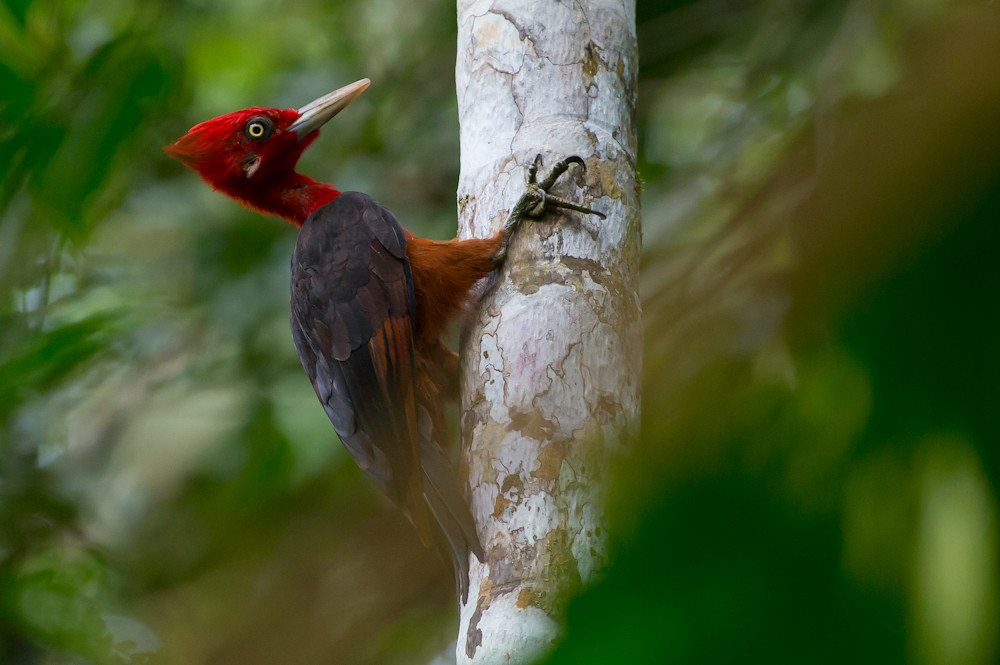When you lay your eyes on the red-necked woodpecker you are naturally captivated by its red headed beauty. Even though it is small in body size, its long bill makes some loud pecking sounds that catches your attention right away. Sometimes it can be a little annoying when you hear it too much. Woodpeckers are part of the family Picidae, a group of near-passerine birds that also consist of piculets, wrynecks, and sapsuckers. Members of this family are chiefly known for their characteristic behavior. Read on to find out how to identify them and learn about their fascinating behaviors.
Identifying The Red-necked Woodpecker
- Male Coloration – The male is characterized by entirely black upperparts (with no white back streaks), and entirely red and rufous underparts, with no white streak up the neck, as is present in several other members of the genus. The entire head and neck are red, with an inconspicuous black-and-white spot on the lower feathers that cover the bird’s ear opening.
- Female Coloration – Females are similar but have a broad whitish stripe from the base of the bill to below and beyond the eye. It overlaps throughout Amazonia with Crimson-crested, which is easily distinguished from Red-necked by plumage in having barred (black and dirty white) underparts, and a distinctive white “V” on the back. In areas of overlap, the Red-necked generally prefers more intact tall forest.
Scientific Classification Of The Red-necked Woodpecker
Red-necked Woodpecker – Campephilus rubricollis [Scientific name]
- Kingdom: Animalia
- Phylum: Chordata
- Class: Aves
- Order: Piciformes
- Family: Picidae
- Genus: Campephilus
- Species: C. rubricollis
Habitat Of The Red-necked Woodpecker
The Red-necked Woodpecker is a large, spectacular Campephilus woodpecker of the rainforest Along with Crimson-crested Woodpecker (Campephilus melanoleucos), it is the common large woodpecker of the Amazonian forest. It is found in Bolivia, Brazil, Colombia, Ecuador, French Guiana, Guyana, Peru, Suriname, and Venezuela. Its natural habitats are subtropical or tropical moist lowland forest and subtropical or tropical moist montane forest.
Tip: It occurs in pairs and family groups, and seeks out large dead trunks within the forest.
Behavior & Lifestyle
They mostly forage for insect prey on the trunks and branches of trees, and often communicate by drumming with their beak, producing a reverberatory sound that can be heard at some distance. They mostly nest and roost in holes that they excavate in tree trunks, and their abandoned holes are of importance to other cavity-nesting birds. They sometimes come into conflict with humans when they make holes in buildings or feed on fruit crops, but perform a useful service by their removal of insect pests on trees.
Did You Know? The red-necked woodpecker’s main vocalization is an explosive nasal call (“ngkah-ngkah” or “kikka”) repeated frequently. The drum, as in most other members of the genus, is a loud “double-rap.”
Drumming Skills
Drumming is a form of non-vocal communication used by most woodpeckers and involves the bill being repeatedly struck on a hard surface with great rapidity. After a pause, the drum roll is repeated, each species having a pattern which is unique in the number of beats in the roll, the length of the roll, the length of the gap between rolls and the cadence. The drumming is mainly a territorial call, equivalent to the song of a passerine, with male birds drumming more frequently than females. Woodpeckers choose a surface that resonates, such as a hollow tree, and may use man-made structures such as gutters and downpipes. Drumming serves for the mutual recognition of conspecifics and plays a part in courtship rituals. Individual birds are thought to be able to distinguish the drumming of their mates and that of their neighbors.
Diet & Feeding
The majority of woodpeckers live up to their name and feed on insects and other invertebrates living under bark and in wood, but overall the family is characterized by its dietary flexibility, with many species being both highly omnivorous and opportunistic. The diet includes ants, termites, beetles and their larvae, caterpillars, spiders, other arthropods, bird eggs, nestlings, small rodents, lizards, fruit, nuts and sap. Many insects and their grubs are taken from living and dead trees by excavation. The bird may hear sounds from inside the timber indicating where it will be productive to create a hole.
Red-necked Woodpecker In Guyana
The red-necked woodpecker is indeed a fascinating bird found in Guyana. For starters, their eye-catching color and loud drumming makes them very conspicuous. Even though their drumming can prove to be irritating at times, it is good in a way since they remove pest and insects from posts, etc. Also, the drumming is a form of communication and also plays a part in courtship rituals. All of this shows us reasons for the lifestyle and eating habits of the red-necked woodpecker. We are privileged to have them in Guyana.
Article References:
- https://en.wikipedia.org/wiki/Woodpecker
- https://neotropical.birds.cornell.edu/Species-Account/nb/species/renwoo1/overview
- https://en.wikipedia.org/wiki/Red-necked_woodpecker
- Main Image: https://www.flickr.com/photos/jquental/15067834311
Discover more from Things Guyana
Subscribe to get the latest posts sent to your email.







